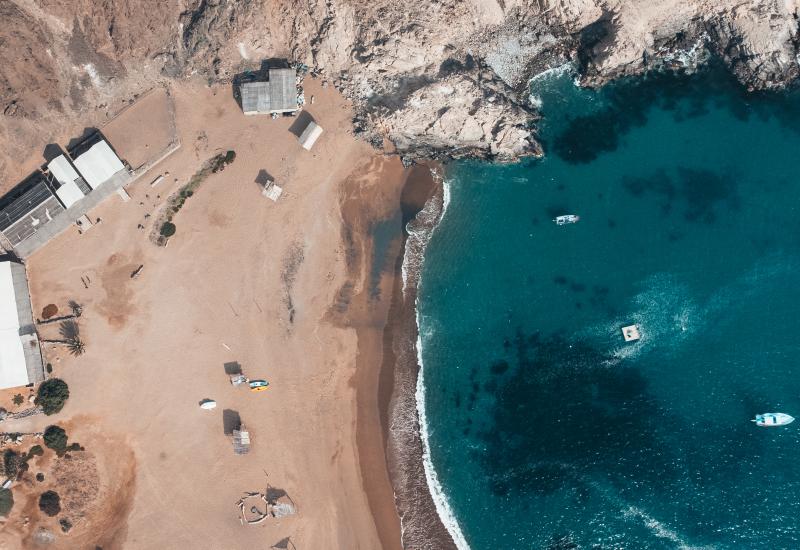Drive and Dive: California's Sonoma Coast
The Golden State is often recognized for the beautiful diving of San Diego’s Wreck Alley, as well as the charismatic sea lions and giant kelp of the Channel Islands, and the diverse waters of the Monterey Bay Marine Sanctuary. While these established areas offer world-class temperate diving, there’s an entire world of lesser-known, seldom-visited sites not far above San Francisco, along the Sonoma coast, that offer magnificent kelp forests of a different type.
Putting the urban metropolis of San Francisco in your rear-view mirror and driving north along the famed Pacific Coast Highway toward Mendocino offers an experience unto itself — the panoramic coastal scenery is second to none. Steep cliffs, the expanse of the Pacific Ocean, and striking offshore sea stacks present a remarkable backdrop, but be sure to keep your eyes mostly on the snaking road!
While the winding drive is nothing less than gor geous, those who take the time to explore a few of the sporadic sheltered coves along this impressive shoreline will not regret it. Incessant pounding from Pacific waves has molded the shore into jagged, rock-strewn contours that hide a plethora of unique underwater habitats. Generated in the northern Pacific by west-wind drift, and mingling with the southern parts of the Alaskan current, the cold water of the California current seeps down the entire west coast. It carries with it nutrient-rich water that feeds plankton, healthy stocks of fish, and all sorts of colorful invertebrates that hide in nooks and cling to rocks.
Suiting up on one of the many beaches between San Francisco and Mendocino, and then swimming out amid northern California waters, opens the door to an underwater world that is hardly ever explored. It usually takes a few moments for your eyes to adjust to the shadowy underworld beneath the long, sinuous blades of kelp. Bright beams of light illuminate the rock- strewn bottom thickly carpeted with an understory of dark-green palm kelp that grips stone and dances fluidly in ever-present currents. Growing even higher in the water column is the Dr. Seuss-like bull kelp, where a variety of black, blue and yellowtail rockfish hover motionless, each appearing to prefer a particular depth. Large, camouflaged cabezon blend in almost perfectly among hydroids, anemones and rocks on the bottom. Their detailed color patterns and textures are worth spending more than a few moments to observe.
On calm days, just about anywhere along the Sonoma coast is a potential dive site, but if there’s a bit of swell, it’s best to head to more-sheltered alcoves. Stillwater Cove Regional Park is one of the more-quaint sites accessible to divers of all experience levels. The marine environment here is largely untouched and heavily protected: A limited number of divers are allowed access to the cove on any given day. So it is no surprise that the U-shaped cove is home to a wealth of macro critters; nudibranchs, crabs and abalone are often found dwelling beneath layers of algae and sea lettuce. Topside, harbor seals are occasionally seen lounging on the rocky ridge to the left of the cove.
Nearby, Gerstle Cove in Salt Point State Park is one of California’s oldest underwater preserves. The park touts a picturesque bay carved into the rugged coastline. Here, even while moderate swells pound offshore boulders, you can enjoy an easy beach entry and a beautiful, protected site chock-full of marine life. Coralline algae, tunicates and fields of sea stars cover the rocks, while sculpin and giant kelpfish blend into the shadowed surroundings. Conveniently, there are well-maintained showers and restrooms in the nearby parking lot.
Van Damme State Park, just south of the quaint town of Mendocino, is a popular site for abalone divers, but it’s optimal for recreational scuba diving as well. With easy entry and exits, and parking within 25 yards of the water, Van Damme offers shallow, sloping kelp beds that hide a healthy cold-water ecosystem. Everything that prefers temperate waters, from a variety of delicate nudibranchs, colorful anemones and alien-looking jellyfish to schools of rockfish, veiled lingcod and the occasional wolf eel, can be spotted near the undulating rocky bottom.
After spending even a few days exploring the hidden coves and marine terraces in this untamed and unspoiled region, you can’t help but be influenced by its wildness and almost-painful beauty. Mother Nature, red in tooth and claw, is so evident in these parts that it will remind you of John Steinbeck’s writings. Although there’s effort and patience involved in diving the hardy shores of northern California, the matchless scenery above and below the Pacific waterline unquestionably makes the trip a worthwhile endeavor.
Want to make the trip? Click here for what you need to know!

Ethan DanielsLittle-known dive sites off the rocky coast of northern California provide stunning views in and out of water.
The Golden State is often recognized for the beautiful diving of San Diego’s Wreck Alley, as well as the charismatic sea lions and giant kelp of the Channel Islands, and the diverse waters of the Monterey Bay Marine Sanctuary. While these established areas offer world-class temperate diving, there’s an entire world of lesser-known, seldom-visited sites not far above San Francisco, along the Sonoma coast, that offer magnificent kelp forests of a different type.

Ethan DanielsDr. Suess-like bull kelp can be found at NorCal dive sites.
Putting the urban metropolis of San Francisco in your rear-view mirror and driving north along the famed Pacific Coast Highway toward Mendocino offers an experience unto itself — the panoramic coastal scenery is second to none. Steep cliffs, the expanse of the Pacific Ocean, and striking offshore sea stacks present a remarkable backdrop, but be sure to keep your eyes mostly on the snaking road!

Ethan DanielsThe cold water of the California current seeps down the entire west coast. It carries with it nutrient-rich water that feeds plankton, healthy stocks of fish and all sort of colorful invertebrates (like starfish) that hide in nooks and cling to rocks.
While the winding drive is nothing less than gor geous, those who take the time to explore a few of the sporadic sheltered coves along this impressive shoreline will not regret it. Incessant pounding from Pacific waves has molded the shore into jagged, rock-strewn contours that hide a plethora of unique underwater habitats. Generated in the northern Pacific by west-wind drift, and mingling with the southern parts of the Alaskan current, the cold water of the California current seeps down the entire west coast. It carries with it nutrient-rich water that feeds plankton, healthy stocks of fish, and all sorts of colorful invertebrates that hide in nooks and cling to rocks.
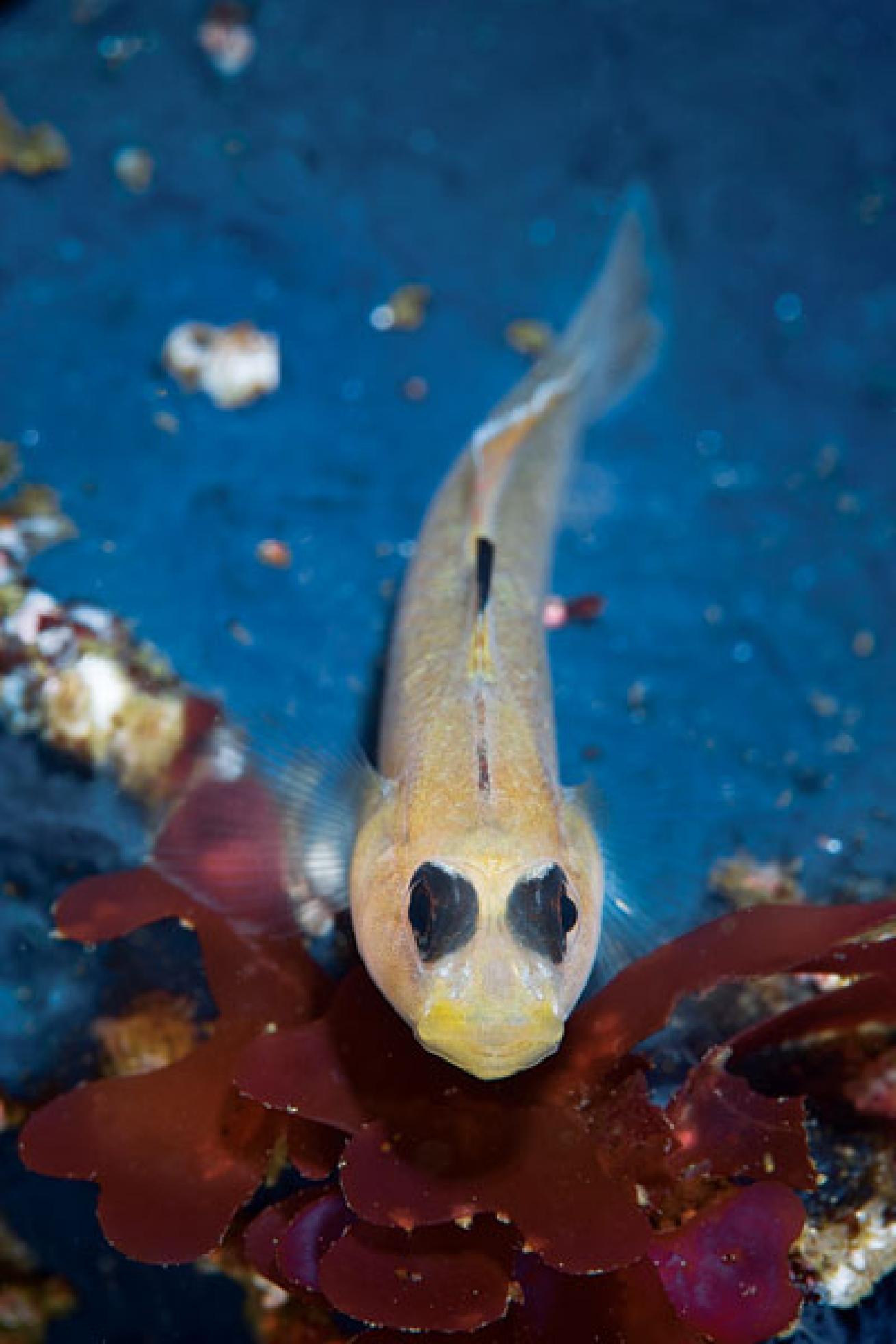
Ethan DanielsSwimming out amid northern California waters opens the door to an underwater world that is hardly ever explored.
Suiting up on one of the many beaches between San Francisco and Mendocino, and then swimming out amid northern California waters, opens the door to an underwater world that is hardly ever explored. It usually takes a few moments for your eyes to adjust to the shadowy underworld beneath the long, sinuous blades of kelp. Bright beams of light illuminate the rock- strewn bottom thickly carpeted with an understory of dark-green palm kelp that grips stone and dances fluidly in ever-present currents. Growing even higher in the water column is the Dr. Seuss-like bull kelp, where a variety of black, blue and yellowtail rockfish hover motionless, each appearing to prefer a particular depth. Large, camouflaged cabezon blend in almost perfectly among hydroids, anemones and rocks on the bottom. Their detailed color patterns and textures are worth spending more than a few moments to observe.
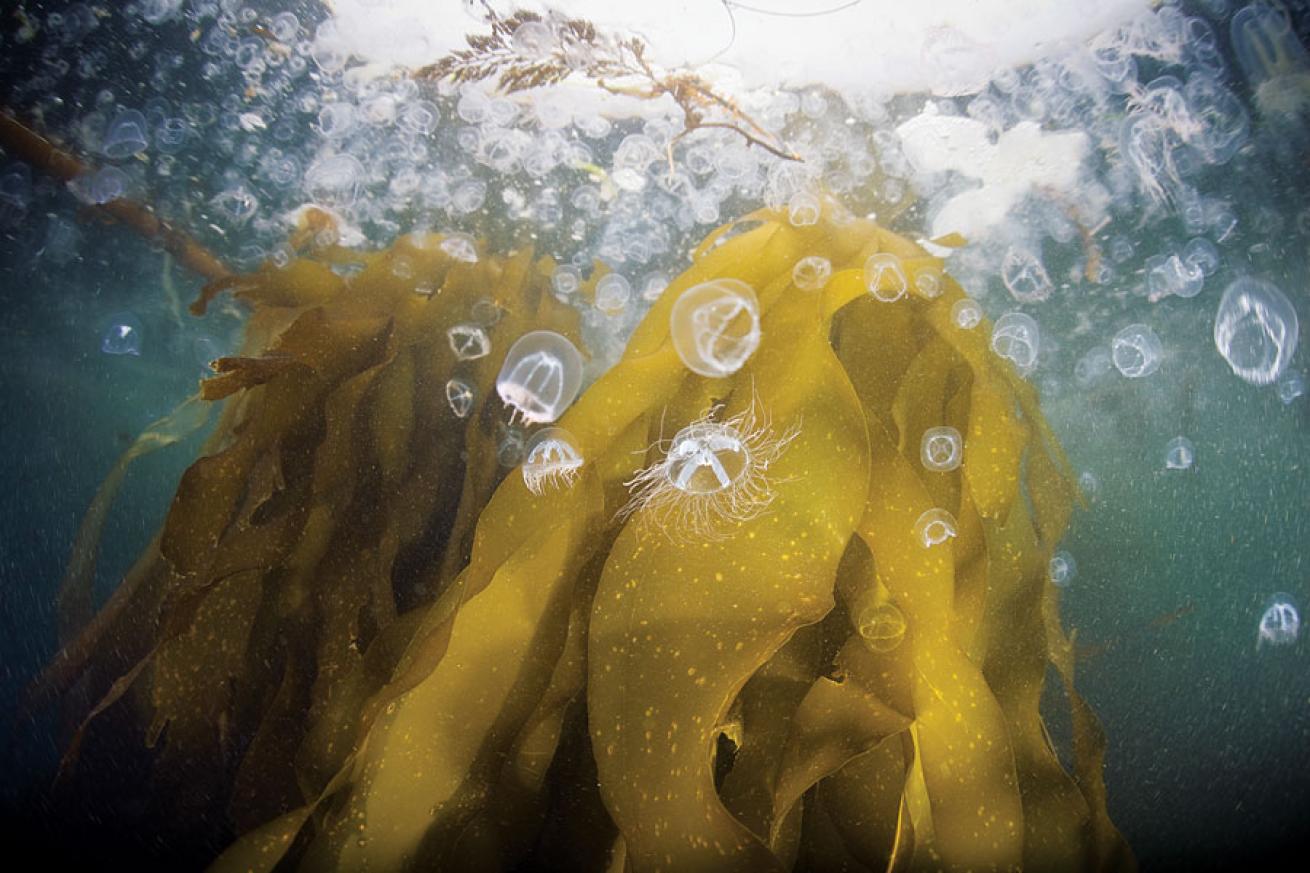
Ethan DanielsAn aggregation of jellyfish drifts through bull kelp.
On calm days, just about anywhere along the Sonoma coast is a potential dive site, but if there’s a bit of swell, it’s best to head to more-sheltered alcoves. Stillwater Cove Regional Park is one of the more-quaint sites accessible to divers of all experience levels. The marine environment here is largely untouched and heavily protected: A limited number of divers are allowed access to the cove on any given day. So it is no surprise that the U-shaped cove is home to a wealth of macro critters; nudibranchs, crabs and abalone are often found dwelling beneath layers of algae and sea lettuce. Topside, harbor seals are occasionally seen lounging on the rocky ridge to the left of the cove.
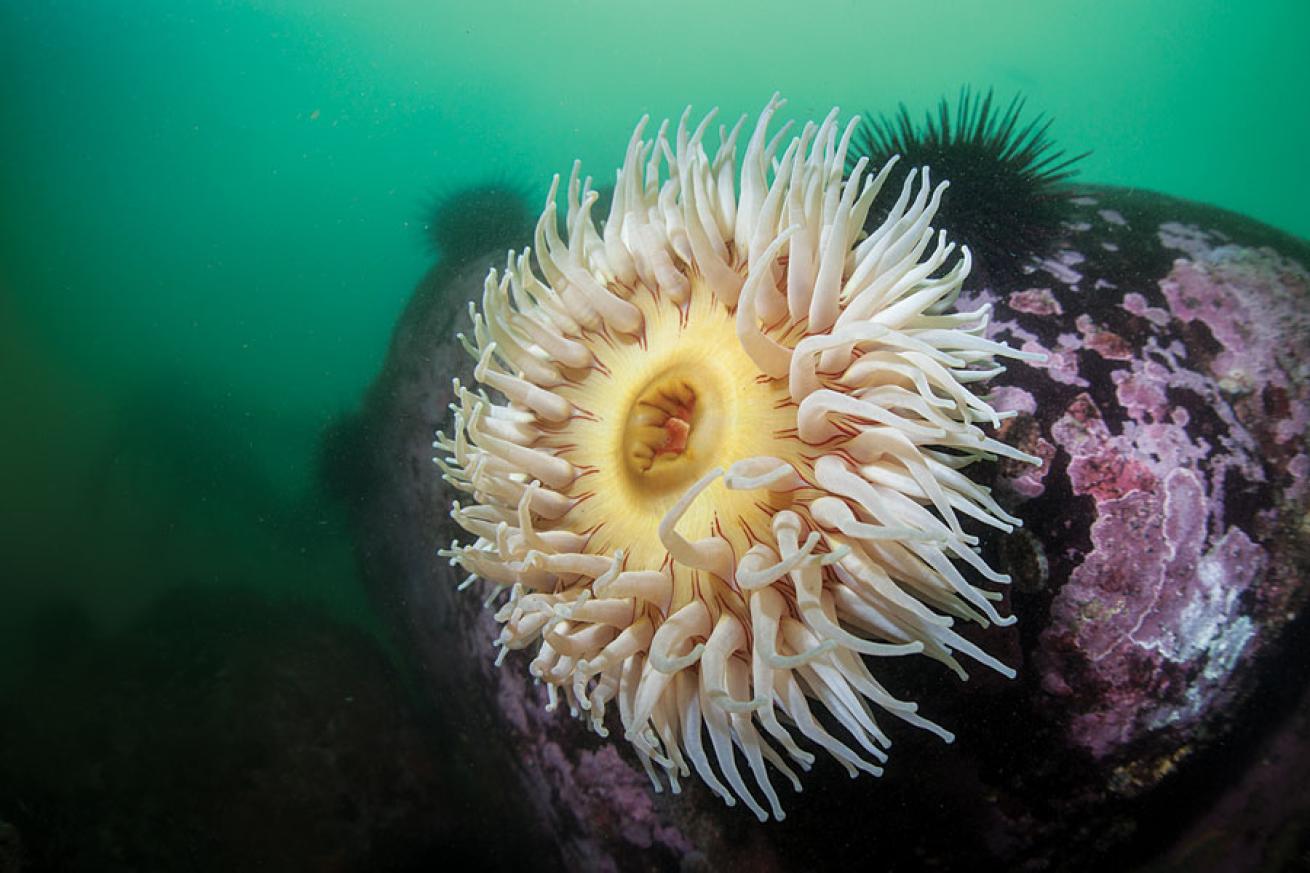
Ethan DanielsA fish-eating anemone extends its tentacles in northern California waters.
Nearby, Gerstle Cove in Salt Point State Park is one of California’s oldest underwater preserves. The park touts a picturesque bay carved into the rugged coastline. Here, even while moderate swells pound offshore boulders, you can enjoy an easy beach entry and a beautiful, protected site chock-full of marine life. Coralline algae, tunicates and fields of sea stars cover the rocks, while sculpin and giant kelpfish blend into the shadowed surroundings. Conveniently, there are well-maintained showers and restrooms in the nearby parking lot.
Van Damme State Park, just south of the quaint town of Mendocino, is a popular site for abalone divers, but it’s optimal for recreational scuba diving as well. With easy entry and exits, and parking within 25 yards of the water, Van Damme offers shallow, sloping kelp beds that hide a healthy cold-water ecosystem. Everything that prefers temperate waters, from a variety of delicate nudibranchs, colorful anemones and alien-looking jellyfish to schools of rockfish, veiled lingcod and the occasional wolf eel, can be spotted near the undulating rocky bottom.
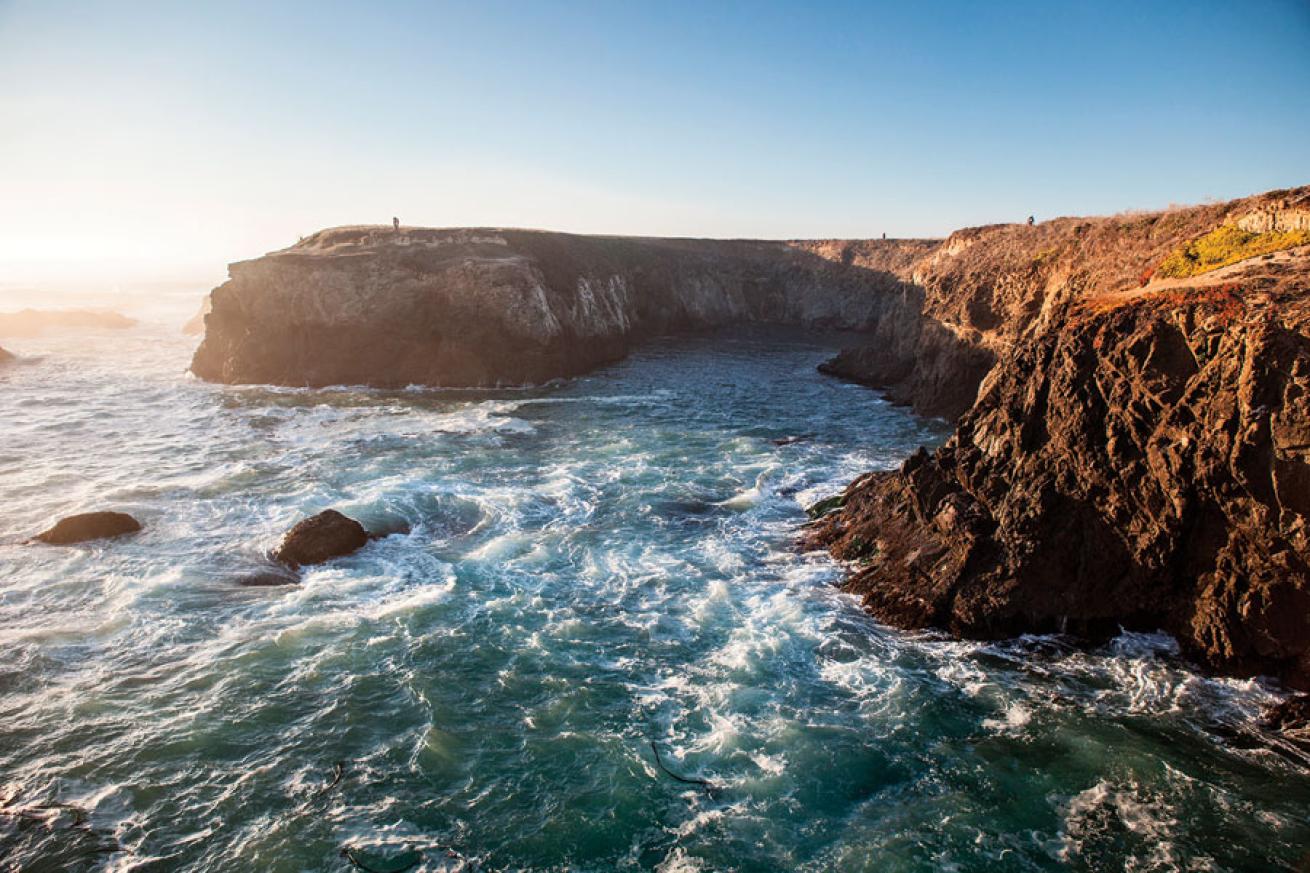
Ethan DanielsThere are a number of little-known dive sites off the rocky coast of northern California.
After spending even a few days exploring the hidden coves and marine terraces in this untamed and unspoiled region, you can’t help but be influenced by its wildness and almost-painful beauty. Mother Nature, red in tooth and claw, is so evident in these parts that it will remind you of John Steinbeck’s writings. Although there’s effort and patience involved in diving the hardy shores of northern California, the matchless scenery above and below the Pacific waterline unquestionably makes the trip a worthwhile endeavor.
Want to make the trip? Click here for what you need to know!




